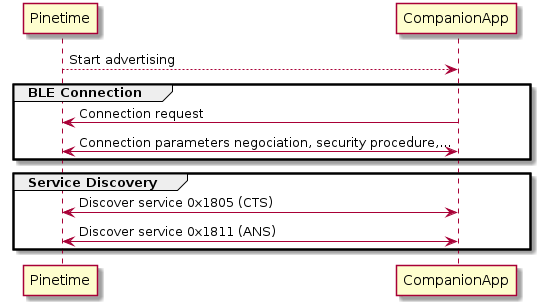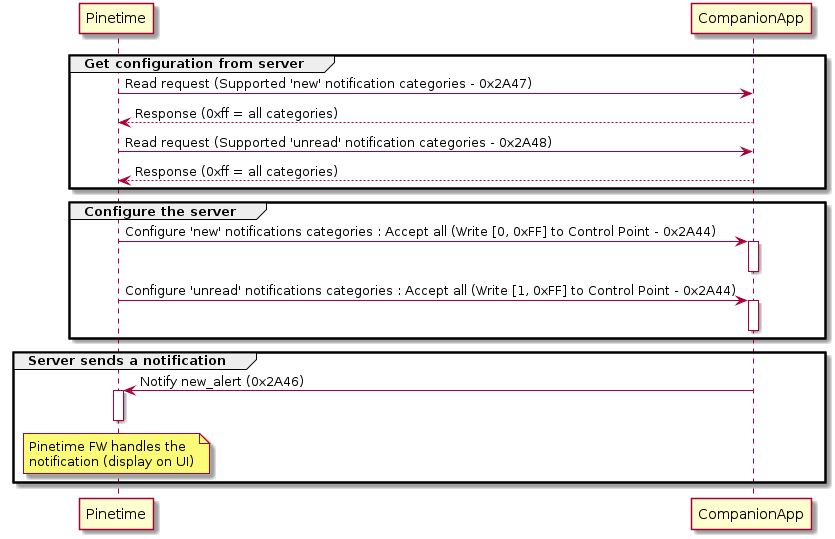12 KiB
Bluetooth Low-Energy :
Introduction
This page describes the BLE implementation and API built in this firmware.
Note : I'm a beginner in BLE related technologies and the information in this document reflects my current knowledge and understanding of the BLE stack. This information might be erroneous or incomplete. Feel free to submit a PR if you think you can improve it.
Table of Contents
- BLE Connection
- BLE UUIDs
- BLE Services
- Getting Information
- Notifications
- Firmware Upgrades
- Music Control
- Time
BLE Connection
When starting, the firmware starts BLE advertising. It sends small messages that can be received by any central device in range. This allows the device to announce its presence to other devices.
A companion application (running on a PC, Raspberry Pi, smartphone, etc.) which receives this advertising packet can request a connection to the device. This connection procedure allows the 2 devices to negotiate communication parameters, security keys, etc.
When the connection is established, the PineTime will try to discover services running on the companion application. For now CTS (Current Time Service) and ANS (Alert Notification Service) are supported.
If CTS is detected, it'll request the current time to the companion application. If ANS is detected, it will listen to new notifications coming from the companion application.
BLE UUIDs
When possible, InfiniTime tries to implement BLE services defined by the BLE specification.
When the service does not exist in the BLE specification, InfiniTime implements custom services. Custom services are identified by a UUID, as are all BLE services. Here is how to define the UUID of custom services in InfiniTime:
- Base UUID : xxxxxxxx-78fc-48fe-8e23-433b3a1942d0
- Service UUID : SSSS0000-78fc-48fe-8e23-433b3a1942d0 where SSSS is the service ID
- Characteristic UUID : SSSSCCCC-78fc-48fe-8e23-433b3a1942d0 where CCCC is the characteristic ID for the service SSSS and is different than 0
The following custom services are implemented in InfiniTime:
-
Since InfiniTime 0.8:
- Music Service : 00000000-78fc-48fe-8e23-433b3a1942d0
-
Since InfiniTime 0.11:
- Navigation Service : 00010000-78fc-48fe-8e23-433b3a1942d0
-
Since InfiniTime 0.13
- Call characteristic (extension to the Alert Notification Service): 00020001-78fc-48fe-8e23-433b3a1942d0
-
Since InfiniTime 1.7:
- Motion Service : 00030000-78fc-48fe-8e23-433b3a1942d0
BLE services
CTS
ANS
Getting Information
The InfiniTime firmware exposes some information about itself through BLE. The BLE characteristic UUIDs for this information are as follows:
- Firmware Version:
00002a26-0000-1000-8000-00805f9b34fb - Battery Level:
00002a19-0000-1000-8000-00805f9b34fb - Heart Rate:
00002a37-0000-1000-8000-00805f9b34fb
Firmware Version
Reading a value from the firmware version characteristic will yield a UTF-8 encoded string containing the version of InfiniTime being run on the device. Example: 1.6.0.
Battery Level
Reading from the battery level characteristic yields a single byte of data. This byte can be converted to an unsigned 8-bit integer which will be the battery percentage. This characteristic allows notify for updates as the value changes.
Heart Rate
Reading from the heart rate characteristic yields two bytes of data. I am not sure of the function of the first byte. It appears to always be zero. The second byte can be converted to an unsigned 8-bit integer which is the current heart rate. This characteristic also allows notify for updates as the value changes.
Notifications
InfiniTime uses the Alert Notification Service (ANS) for notifications. The relevant UUIDs are as follows:
- New Alert:
00002a46-0000-1000-8000-00805f9b34fb - Notification Event:
00020001-78fc-48fe-8e23-433b3a1942d0
New Alert
The new alert characteristic allows sending new notifications to InfiniTime. It requires the following format:
<category><amount>\x00<\x00-separated data>
For example, here is what a normal notification looks like in Golang (language of itd):
// \x00 is the category for simple alert, and there is one new notifcation, hence \x01.
"\x00\x01\x00Test Title\x00Test Body"
A call notification looks like so:
// \x03 is the category for calls, and there is one new call notifcation, hence \x01.
"\x03\x01\x00Mary"
The \x00 stands for hexadecimal 00 which means null.
Here is the list of categories and commands:
- Simple Alert:
0 - Email:
1 - News:
2 - Call Notification:
3 - Missed Call:
4 - SMS/MMS:
5 - Voicemail:
6 - Schedule:
7 - High Prioritized Alert:
8 - Instant Message:
9 - All Alerts:
0xFF
These lists and information were retrieved from the following pages in the Nordic docs:
Notification Event
A call notification in InfiniTime contains three buttons. Decline, Accept, and Mute. The notification event characteristic contains the button tapped by the user on a call notification. This characteristic only allows notify, not read.
Enabling notifications from this characteristic, you get a single byte whenever the user taps a button on the call notification. This byte is an unsigned 8-bit integer that signifies one of the buttons. The numbers are as follows:
- 0: Declined
- 1: Accepted
- 2: Muted
Firmware Upgrades
Firmware upgrades in InfiniTime are probably the most complex of the BLE operations. It is a nine step process requiring multiple commands be sent to multiple characteristics. The relevant UUIDs are as follows:
- Control Point:
00001531-1212-efde-1523-785feabcd123 - Packet:
00001532-1212-efde-1523-785feabcd123
A DFU upgrade archive for InfiniTime consists of multiple files. The most important being the .bin and .dat files. The first is the actual firmware, while the second is a packet that initializes DFU. Both are needed for a DFU upgrade.
The first thing to do is to enable notifications on the control point characteristic. This will be needed for verifying that the proper responses are being sent back from InfiniTime.
Step one
For the first step, write 0x01, 0x04 to the control point characteristic. This will signal InfiniTime that a DFU upgrade is to be started.
Step two
In step two, send the total size in bytes of the firmware file to the packet characteristic. This value should be an unsigned 32-bit integer encoded as little-endian. In front of this integer should be 8 null bytes. This is because there are three items that can be updated and each 4 bytes is for one of those. The last four are for the InfiniTime application, so those are the ones that need to be set.
Step three
Before running step three, wait for a response from the control point. This response should be 0x10, 0x01, 0x01 which indicates a successful DFU start. In step three, send 0x02, 0x00 to the control point. This will signal InfiniTime to expect the init packet on the packet characteristic.
Step four
The previous step prepared InfiniTime for this one. In this step, send the contents of the .dat init packet file to the packet characteristic. After this, send 0x02, 0x01 indicating that the packet has been sent.
Step five
Before running this step, wait to receive 0x10, 0x02, 0x01 which indicates that the packet has been received. During this step, send the packet receipt interval to the control point. The firmware file will be sent in segments of 20 bytes each. The packet receipt interval indicates how many segments should be received before sending a receipt containing the amount of bytes received so that it can be confirmed to be the same as the amount sent. This is very useful for detecting packet loss. itd uses 0x08, 0x0A which indicates 10 segments.
Step six
In step six, write 0x03 to the control point, indicating that the firmware will be sent next on the packet characteristic.
Step seven
This step is the most difficult. Here, the actual firmware is sent to InfiniTime.
As mentioned before, the firmware file must be split up into segments of 20 bytes each and sent to the packet characteristic one by one. Every 10 segments (or whatever you have set the interval to), check for a response starting with 0x11. The rest of the response will be the amount of bytes received encoded as a little-endian unsigned 32-bit integer. Confirm that this matches the amount of bytes sent, and then continue sending more segments.
Step eight
Before running this step, wait to receive 0x10, 0x03, 0x01 which indicates a successful receipt of the firmware image. In this step, write 0x04 to the control point to signal InfiniTime to validate the image it has received.
Step nine
Before running this step, wait to receive 0x10, 0x04, 0x01 which indicates that the image has been validated. In this step, send 0x05 to the control point as a command with no response. This signals InfiniTime to activate the new firmware and reboot.
Once all of these steps are complete, the DFU is complete. Don't forget to validate the firmware in the settings.
Music Control
InfiniTime contains a music controller app which is meant to control the music playback and volume through the companion.
The following UUIDs are relevant to this:
- Events:
00000001-78fc-48fe-8e23-433b3a1942d0 - Status:
00000002-78fc-48fe-8e23-433b3a1942d0 - Artist:
00000003-78fc-48fe-8e23-433b3a1942d0 - Track:
00000004-78fc-48fe-8e23-433b3a1942d0 - Album:
00000005-78fc-48fe-8e23-433b3a1942d0
Events
The events characteristic is meant to respond to user input in the music controller app.
Enabling notifications on this characteristic gives you a single byte upon any event. This byte can be converted to an unsigned 8-bit integer which corresponds to each possible event. Here are the events:
- App Opened:
0xe0 - Play:
0x00 - Pause:
0x01 - Next:
0x03 - Previous:
0x04 - Volume up:
0x05 - Volume down:
0x06
Status
The status characteristic allows setting the playing status of music. Send 0x01 to the status characteristic for playing, and 0x00 for paused.
Artist, Track, and Album
These characteristics all work the same way. Simply send a UTF-8 encoded string to the relevant characteristic in order to set the value in the app.
Time
InfiniTime allows setting its time via the Current Time Service (CTS)
The UUID for the current time characteristic is: 00002a2b-0000-1000-8000-00805f9b34fb
This characteristic expects a particular format:
- Year (
uint16) - Month (
uint8) - Day (
uint8) - Hour (
uint8) - Minute (
uint8) - Second (
uint8) - Weekday (
uint8) - Microsecond divided by
1e6*256(uint8) - Binary 0001 (
uint8)
Write all of these together, encoded as little-endian, to the current time characteristic.

